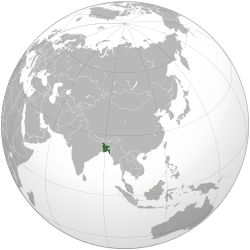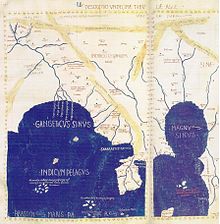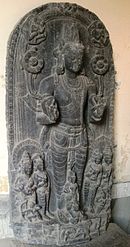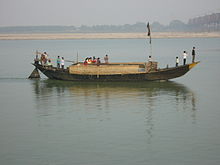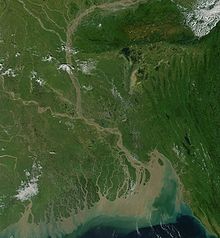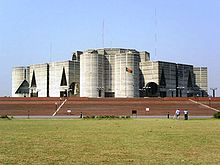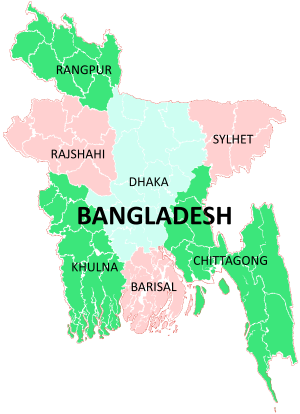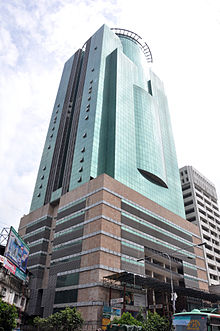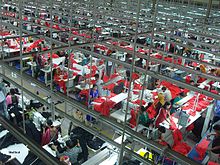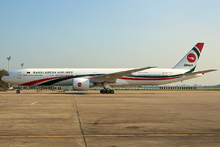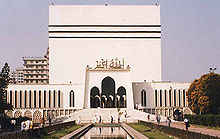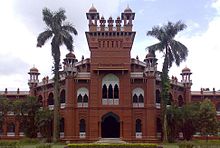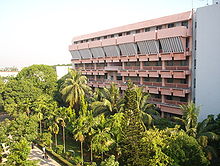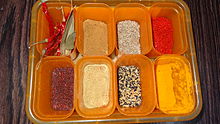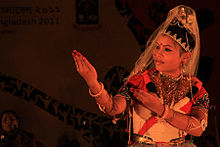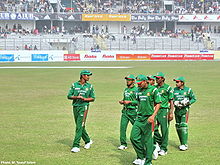
Bangladesh
Background to the schools Wikipedia
Arranging a Wikipedia selection for schools in the developing world without internet was an initiative by SOS Children. Visit the SOS Children website at http://www.soschildren.org/
People's Republic of Bangladesh
|
||||||
|---|---|---|---|---|---|---|
|
||||||
Anthem:
|
||||||
|
|
||||||
| Capital and largest city |
Dhaka 23°42′N 90°21′E |
|||||
| Official languages | Bangla | |||||
| Recognised regional languages | English | |||||
| Ethnic groups (1998) |
|
|||||
| Demonym | Bangladeshi | |||||
| Government | Unitary parliamentary democracy | |||||
| - | President | Zillur Rahman | ||||
| - | Prime Minister | Sheikh Hasina | ||||
| - | Speaker | Abdul Hamid | ||||
| Legislature | Jatiyo Sangshad | |||||
| Independence from Islamic Republic of Pakistan | ||||||
| - | Declared | 26 March 1971 | ||||
| - | Current constitution | 4 November 1972 | ||||
| Area | ||||||
| - | Total | 147,570 km2 ( 94th) 56,977 sq mi |
||||
| - | Water (%) | 6.4 | ||||
| Population | ||||||
| - | July 2012 estimate | 161,083,804 ( 8th) | ||||
| - | Density | 1,033.5/km2 ( 9th) 2,676.8/sq mi |
||||
| GDP ( PPP) | 2011 estimate | |||||
| - | Total | $282.229 billion ( 44) | ||||
| - | Per capita | 1,909.461(2011 est) ( 155) | ||||
| GDP (nominal) | 2011 estimate | |||||
| - | Total | 113.855 billion ( 59) | ||||
| - | Per capita | $700.59 | ||||
| Gini (2005) | 33.2 medium |
|||||
| HDI (2011) | low · 146th |
|||||
| Currency | Taka ( BDT) |
|||||
| Time zone | BST ( UTC+6) | |||||
| Drives on the | left | |||||
| Calling code | 880 | |||||
| ISO 3166 code | BD | |||||
| Internet TLD | .bd | |||||
Bangladesh ( / ˈ b ɑː ŋ ɡ l ə d ɛ ʃ /, / ˌ b ɑː ŋ ɡ l ə ˈ d ɛ ʃ /, / ˌ b æ ŋ ɡ l ə ˈ d ɛ ʃ /, / ˌ b ʌ ŋ ɡ l ə ˈ d ɛ ʃ / ; Bengali: বাংলাদেশ, pronounced: [ˈbaŋlad̪eʃ]), officially the People's Republic of Bangladesh (গণপ্রজাতন্ত্রী বাংলাদেশ Gônoprojatontri Bangladesh), is a country in South Asia. Straddling the fertile Ganges-Brahmaputra Delta, it is part of the historic ethno-linguistic region of Bengal. The name Bangladesh means "Country of Bengal" in the official Bengali language. It faces the Bay of Bengal to its south, and is bordered by India on the north, west and east, as well as Burma (Myanmar) on the southeast. It is separated from the Himalayan nations of Nepal and Bhutan by India’s narrow Siliguri corridor, and is in geographical proximity to China.
The present-day borders of Bangladesh were established during the British partition of Bengal in 1947, when the region became East Bengal (later East Pakistan), part of the newly formed nation of Pakistan. However, it was separated from West Pakistan by nearly 1,500 km (about 900 mi) of Indian territory. Due to political exclusion, ethnic and linguistic discrimination and economic neglect by the politically dominant western wing, popular agitation grew and gave rise to a secular cultural nationalist movement, leading to the declaration of independence and Bangladesh Liberation War in 1971. In the aftermath of war and independence, the new state endured poverty, famine, political turmoil and military coups. The restoration of democracy in 1991 has been followed by relative calm and economic progress. Today, Bangladesh is a secular, unitary, constitutional republic.
Bangladesh is a parliamentary democracy, with an elected parliament called the Jatiyo Sangshad. It is the world's eighth most populous country and has one of the highest population densities in the world. The country is identified as a Next Eleven economy. A pioneer of regional engagement in South Asia, Bangladesh is a founding member of SAARC and BIMSTEC. It is also member of the Commonwealth, the Non-Aligned Movement, the OIC, the Developing 8 Countries and BIMSTEC.
The country faces a number of major challenges, including poverty, corruption, overpopulation and vulnerability to climate change. However, it has been noted by the international community for its progress on the Human Development Index. The country has greatly increased life expectancy, achieved gender parity in education, reduced population growth and improved maternal and child health. Dhaka and Chittagong, the country's two largest cities, have been the driving force behind much of the recent growth.
History
Antiquity
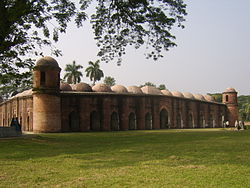
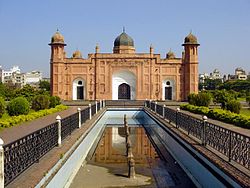
Remnants of civilization in the greater Bengal region date back four thousand years, when the region was settled by Indo-Aryan, Dravidian, Tibeto-Burman, and Austroasiatic peoples. The exact origin of the word "Bangla" or "Bengal" is not known, though it is believed to be derived from Bang/Vanga, the tribe that settled in the area around the year 1000 BCE.
The early history of Bengal featured the rise of Vedic states, a succession of Buddhist empires and Hindu dynasties. During the first millennium BCE, the region was home to the janapadas such as Vanga and Pundravardhana. The Gangaridai state arose in the 7th century BCE, and flourished as a seafaring nation. The region was conquered by Emperor Ashoka in the 2nd century BCE, and was absorbed into the Mauryan Empire. Bengal was later part of the Gupta Empire and the Harsha Empire. Following its collapse, a dynamic Bengali named Shashanka founded an impressive short-lived kingdom. After a period of anarchy, the Bengali Buddhist Pala dynasty ruled the region for four hundred years, followed by a shorter reign of the Hindu Sena dynasty.
Islam was introduced to Bengal in the 9th century, by Arab Muslim traders and Sufi missionaries. Subsequent Muslim rule helped spread Islam throughout the region. Bakhtiar Khilji, a Turkish general, defeated Lakshman Sen of the Sena dynasty and conquered large parts of Bengal in the year 1204. The Sultanate of Bengal was established by Shamsuddin Ilyas Shah in 1342, and ruled the region for the next few hundred years. The Sultans contributed to the development of Bengali culture through patronizing literature and art, and promoted trade and political relations with China and Persia. By the 16th century, the Mughal Empire controlled Bengal, and Dhaka became an important provincial centre of administration. Under the Mughals, agrarian reforms and increased foreign trade brought a high level of prosperity to the region, giving rise to the reputation of "Golden Bengal".
Medieval European geographers located paradise at the mouth of the Ganges and although this was overhopeful, Bengal was probably the wealthiest part of the subcontinent until the 17th century. From 1517 onwards, Portuguese traders were traversing the sea-route to Bengal. Only in 1537, were they allowed to settle and open customs houses at Chittagong. In 1577, Mughal emperor Akbar permitted the Portuguese to build permanent settlements and churches in Bengal. The influence of European traders grew until the British East India Company gained control of Bengal following the Battle of Plassey in 1757. The bloody rebellion of 1857—known as the Sepoy Mutiny—resulted in transfer of authority to the crown with a British viceroy running the administration. During colonial rule, famine racked South Asia many times, including the war-induced Great Bengal famine of 1943 that claimed 3 million lives.
The Maratha Empire, a Hindu empire which overran the Mughals in the 18th century, also devastated the territories controlled by the Nawab of Bengal between 1742 and 1751. In a series of raids on Bengal and Bihar, then ruled by the Nawab, Maratha demolished much of the Bengali economy, which was unable to withstand the continuous onslaught of Maratha for long. Nawab Ali Vardi Khan made peace with Maratha by ceding the whole of Orissa and parts of Western Bengal to the empire. In addition, this a tax – the Chauth, amounting to a quarter of total revenue – was imposed on other parts of Bengal and Bihar. This tax amounted to twenty lakhs (of rupees?) for Bengal and 12 lakhs for Bihar per year. After Maratha's defeat in Panipat by a coalition of Muslim forces, the empire returned under the Maratha general Madhoji Sindhia and raided Bengal again. The British Empire stopped payment of the Chauth, invading the territory of Bengal in 1760s. The raids continued until Maratha was finally defeated by the British over the course of three Anglo-Maratha Wars, lasting from 1777 to 1818.
20th century
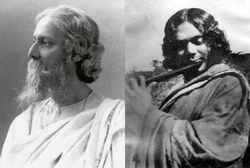
Between 1905 and 1911, an abortive attempt was made to divide the province of Bengal into two zones, with Dhaka being the capital of the eastern zone. With the exit of the British Empire in 1947, Bengal was partitioned along religious lines, with the western part going to newly created India and the eastern part (Muslim majority) joining Pakistan as a province called East Bengal (later renamed East Pakistan), with its capital at Dhaka. In 1950, land reform was accomplished in East Bengal with the abolishment of the feudal zamindari system. Despite the economic and demographic weight of the east, however, Pakistan's government and military were largely dominated by the upper classes from the west. The Bengali Language Movement of 1952 was the first sign of friction between the two wings of Pakistan. Dissatisfaction with the central government over economic and cultural issues continued to rise through the next decade, during which the Awami League emerged as the political voice of the Bengali-speaking population. It agitated for autonomy in the 1960s, and in 1966, its president, Sheikh Mujibur Rahman (Mujib), was jailed; he was released in 1969 after an unprecedented popular uprising. In 1970, a massive cyclone devastated the coast of East Pakistan, killing up to half a million people, and the central government responded poorly. The Bengali population's anger was compounded when Sheikh Mujibur Rahman, whose Awami League won a majority in Parliament in the 1970 elections, was blocked from taking office.

After staging compromise talks with Mujib, President Yahya Khan and military officials launched Operation Searchlight, a sustained military assault on East Pakistan and arrested him in the early hours of 26 March 1971. Yahya's methods were extremely bloody, and the violence of the war resulted in many civilian deaths. Chief targets included intellectuals and Hindus, and about one million refugees fled to neighbouring India. Estimates of those massacred throughout the war range from thirty thousand to 3,000,000. Mujibur Rahman was ultimately released on 8 January 1972, due to direct US intervention.
Awami League leaders set up a government-in-exile in Calcutta, India. The exile government formally took oath at Meherpur, in Kustia district of East Pakistan on 17 April 1971, with Tajuddin Ahmad as the first Prime Minister and Syed Nazrul Islam as the Acting President. The Bangladesh Liberation War lasted for nine months. The Bangladesh Forces formed within 11 sectors led by General M.A.G. Osmani consisting of Bengali Regular forces conducted a massive guerilla war against the Pakistan Forces with support from the Mukti Bahinis consisting of Kaderia Bahni, Hemayet Bahini, and others financed and equipped by Indian Armed Forces Maj. Gen. Sujat Singh Uban. The Indian Army, assisted by Bangladeshi forces, negotiated a cease-fire and surrounded the Dhaka Area. The Indian Army remained in Bangladesh until 19 March 1972.
After its independence, Bangladesh was governed by an Awami League government, with Mujib as the Prime Minister, without holding any elections. In the 1973 parliamentary elections, the Awami League gained an absolute majority. A nationwide famine occurred during 1973 and 1974, and in early 1975, Mujib initiated a one-party socialist rule with his newly formed BAKSAL. On 15 August 1975, Mujib and most of his family members were assassinated by mid-level military officers. Vice President Khandaker Mushtaq Ahmed was sworn in as President with most of Mujib's cabinet intact. Two Army uprisings on 3 November and the other on 7 November 1975 led to the reorganised structure of power. Emergency was declared to restore order and calm, Mushtaq resigned and the country was placed under temporary martial law, with three service chiefs serving as deputies to the new president Justice Abu Sayem, who also became the Chief Martial Law Administrator. Lieutenant General Ziaur Rahman, took over the presidency in 1977 as Justice Sayem resigned. President Ziaur Rahman reinstated multi-party politics, introduced free markets, and founded the Bangladesh Nationalist Party (BNP). Zia's rule ended when he was assassinated by elements of the military in 1981.
Bangladesh's next major ruler was Lieutenant General Hussain Mohammad Ershad, who gained power in a coup on 24 March 1982, and ruled until 6 December 1990, when he was forced to resign after a revolt of all major political parties and the public, along with pressure from Western donors (which was a major shift in international policy after the fall of the Soviet Union). Since then, Bangladesh has reverted to a parliamentary democracy. Zia's widow, Khaleda Zia, led the Bangladesh Nationalist Party to parliamentary victory at the general election in 1991, and became the first female Prime Minister in Bangladeshi history. However, the Awami League, headed by Sheikh Hasina, one of Mujib's surviving daughters, won the next election in 1996. It lost again to the Bangladesh Nationalist Party in 2001.
On 11 January 2007, following widespread political unrest spearheaded by the Awami League, the Bangladesh civil and military establishment supported the establishment of a neutral caretaker government. The caretaker government was appointed to administer the next general election. The country had suffered from extensive corruption, disorder and political violence. The caretaker government made it a priority to root out corruption from all levels of government. To this end, many notable politicians and officials, along with large numbers of lesser officials and party members, were arrested on corruption charges. The caretaker government held what it itself described as a largely free and fair election on 29 December 2008. The Awami League's Sheikh Hasina won with a landslide in the elections and took the oath of Prime Minister on 6 January 2009.
Geography
Bangladesh lies between latitudes 20° and 27°N, and longitudes 88° and 93°E.
Bangladesh is in the low-lying Ganges Delta. This delta is formed by the confluence of the Ganges (local name Padma or Pôdda), Brahmaputra ( Jamuna or Jomuna also known as "Yamuna"), and Meghna rivers and their respective tributaries. The Ganges unites with the Jamuna (main channel of the Brahmaputra) and later joins the Meghna to eventually empty into the Bay of Bengal. The alluvial soil deposited by these rivers has created some of the most fertile plains in the world. Bangladesh has 57 trans-boundary rivers, making water issues politically complicated to resolve – in most cases as the lower riparian state to India.
Most parts of Bangladesh are less than 12 m (39.4 ft) above the sea level, and it is believed that about 10% of the land would be flooded if the sea level were to rise by 1 m (3.28 ft).
In southeast Bangladesh, experiments have been done since the 1960s to 'build with nature'. By implementing cross dams, the natural accretion of silt has created new land. With Dutch funding, the Bangladeshi government began to help develop this new land in the late 1970s. The effort has since become a multiagency operation building roads, culverts, embankments, cyclone shelters, toilets and ponds, as well as distributing land to settlers. By fall 2010, the program will have allotted some 27,000 acres (10,927 ha) to 21,000 families.
The highest point in Bangladesh is in Mowdok range at 1,052 m (3,451 ft) in the Chittagong Hill Tracts to the southeast of the country. Cox's Bazar, south of the city of Chittagong, has a beach that stretches uninterrupted over 120 km (75 mi).
Climate
Straddling the Tropic of Cancer, Bangladeshi climate is tropical with a mild winter from October to March, and a hot, humid summer from March to June. Interestingly, the country has never frozen at any point on the ground, with a record low of 4.5°C in the south west city of Jessore in the winter of 2011. A warm and humid monsoon season lasts from June to October and supplies most of the country's rainfall. Natural calamities, such as floods, tropical cyclones, tornadoes, and tidal bores occur almost every year, combined with the effects of deforestation, soil degradation and erosion. The cyclones of 1970 and 1991 were particularly devastating. A cyclone that struck Bangladesh in 1991 killed some 140,000 people.
In September 1998, Bangladesh saw the most severe flooding in modern world history. As the Brahmaputra, the Ganges and Meghna spilt over and swallowed 300,000 houses, 9,700 km (6,000 mi) of road and 2,700 km (1,700 mi) of embankment, 1,000 people were killed and 30 million more were made homeless, with 135,000 cattle killed, 50 km2 (19 sq mi) of land destroyed and 11,000 km (6,800 mi) of roads damaged or destroyed. Two-thirds of the country was underwater. There were several reasons for the severity of the flooding. Firstly, there were unusually high monsoon rains. Secondly, the Himalayas shed off an equally unusually high amount of melt water that year. Thirdly, trees that usually would have intercepted rain water had been cut down for firewood or to make space for animals.
Bangladesh is now widely recognised to be one of the countries most vulnerable to climate change. Natural hazards that come from increased rainfall, rising sea levels, and tropical cyclones are expected to increase as climate changes, each seriously affecting agriculture, water and food security, human health and shelter. It is believed that in the coming decades the rising sea level alone will create more than 20 million climate refugees. Bangladeshi water is contaminated with arsenic frequently because of the high arsenic contents in the soil. Up to 77 million people are exposed to toxic arsenic from drinking water. Bangladesh is among the countries most prone to natural floods, tornados and cyclones. Also, there is evidence that earthquakes pose a threat to the country. Evidence shows that tectonics have caused rivers to shift course suddenly and dramatically. It has been shown that rainy-season flooding in Bangladesh, on the world’s largest river delta, can push the underlying crust down by as much as 6 centimetres, and possibly perturb faults.
Flora and fauna
A major part of the coastline is marshy jungle, the Sundarbans, the largest mangrove forest in the world and home to diverse flora and fauna, including the Royal Bengal Tiger. In 1997, this region was declared endangered. The Magpie Robin is the National Bird of Bangladesh and it is common and known as the Doyel or Doel (Bengali: দোয়েল). It is a widely used symbol in Bangladesh, appearing on currency notes and a landmark in the city of Dhaka is named as the Doyel Chatwar (meaning: Doyel Square). The national flower of the country is water lily, which is known as Shapla. The national fruit is jackfruit ( Artocarpus heterophyllus), which in Bengali is known as Kathal. In late 2010, the Bangladeshi government selected the Mango tree as the national tree.
Politics
Bangladesh is a unitary state and parliamentary democracy. Direct elections in which all citizens, aged 18 or over, can vote are held every five years for the unicameral parliament known as the Jatiyo Sangshad. Currently it has 350 members (including 50 reserved seats for women) elected from single-member constituencies. The Prime Minister, as the head of government, forms the cabinet and runs the day-to-day affairs of state. While the Prime Minister is formally appointed by the President, he or she must be a member of parliament who commands the confidence of the majority.
The President is the head of state, albeit mainly ceremonially in his/her elected post; however, the President's powers are substantially expanded during the tenure of a caretaker government, which is responsible for the conduct of elections and transfer of power. The officers of the caretaker government must be non-partisan and are given three months to complete their task. This transitional arrangement was pioneered by Bangladesh in its 1991 election and then institutionalised in 1996 through its 13th constitutional amendment.
Major parties in Bangladesh include the Awami League, the Bangladesh Nationalist Party (BNP), the Bangladesh Jamaat-e-Islami (BJI), and the Jatiya Party of former military dictator Ershad. Sheikh Hasina's Awami League aligns with more leftist parties, whereas Khaleda Zia's BNP has politically been allied with Islamist parties like the BJI but practices secular politics. The former two have been bitter, dominant political rivals for over 15 years; each is related to one of the leaders of the independence movement. The Awami League-BNP rivalry has been punctuated by protests, violence and murder. Student politics are particularly strong in Bangladesh, a legacy from the liberation movement era, as almost all parties have highly active student wings, and student leaders have been elected to the Jatiyo Sangshad.
On 11 January 2007, following widespread political unrest, emergency law was declared and a caretaker government was appointed to administer the next general election. The 22 January 2007 election was postponed indefinitely as the Army-backed caretaker government of Fakhruddin Ahmed aimed to prepare a new voter list and crack down on corruption. They also assisted the interim government of Bangladesh in a drive against corruption, which resulted in Bangladesh's position in Transparency International's Corruption Perceptions Index changed from the very bottom, where they had been for 3 years in a row, to 147th in just 1 year. A large alliance led by the Bangladesh Awami League won in a 29 December 2008 landslide victory, gaining 230 seats among 300 seats in the parliament.
Subdivisions
Bangladesh is divided into seven administrative divisions, each named after their respective divisional headquarters: Barisal, Chittagong, Dhaka, Khulna, Rajshahi, Sylhet and Rangpur.
Divisions are subdivided into districts (zila). There are 64 districts in Bangladesh, each further subdivided into upazila (subdistricts) or thana. The area within each police station, except for those in metropolitan areas, is divided into several unions, with each union consisting of multiple villages. In the metropolitan areas, police stations are divided into wards, which are further divided into mahallas. There are no elected officials at the divisional or district levels, and the administration is composed only of government officials. Direct elections are held for each union (or ward), electing a chairperson and a number of members. In 1997, a parliamentary act was passed to reserve three seats (out of 12) in every union for female candidates.
Dhaka is the capital and largest city of Bangladesh. The cities with a city corporation, having mayoral elections, include Dhaka South, Dhaka North, Chittagong, Khulna, Sylhet, Rajshahi, Barisal, Rangpur, Comilla and Gazipur. Other major cities, these and other municipalities electing a chairperson, include Mymensingh, Gopalganj, Jessore, Bogra, Dinajpur, Saidapur, Narayanganj and Rangamati. Both the municipal heads are elected for a span of five years.
| Division | Bangla | 2011 population | Area (km2) | Population density 2011 (people/km2) |
Largest city |
|---|---|---|---|---|---|
| Barisal | বরিশাল | 8,325,666 | 13,297 | 626 | Barisal (328,278) |
| Chittagong | চট্টগ্রাম | 28,423,019 | 33,771 | 841 | Chittagong (2,592,439) |
| Dhaka | ঢাকা | 47,424,418 | 31,120 | 1,523 | Dhaka (7,033,075) |
| Khulna | খুলনা | 15,687,759 | 22,272 | 704 | Khulna (663,342) |
| Rajshahi | রাজশাহী | 18,484,858 | 18,197 | 1,015 | Rajshahi (449,756) |
| Rangpur | রংপুর | 15,787,758 | 16,317 | 960 | Rangpur (343,122) |
| Sylhet | সিলেট | 9,910,219 | 12,596 | 780 | Sylhet (479,837) |
| Bangladesh | 144,043,697 | 147,570 | 976 |
Principal Cities
| Rank | City | Population (2011 Census) |
| 1 | Dhaka | 7,033,075 |
| 2 | Chittagong | 2,592,439 |
| 3 | Khulna | 1,408,350 |
| 4 | Gazipur | 689,411 |
| 5 | Narayanganj | 543,090 |
| 6 | Sylhet | 479,837 |
| 7 | Rajshahi | 449,756 |
| 8 | Barisal | 328,278 |
| 9 | Comilla | 326,386 |
| 10 | Rangpur | 294,265 |
Law
The legal system of Bangladesh is primarily in accordance with the English legal system, although since 1947 the legal scenario and the laws of Bangladesh have drifted far from the West owing to differences in socio-cultural values and religious guidelines. Laws are loosely based on English common law, but family laws such as marriage and inheritance are based on religious scriptures, and therefore differ between religious communities. The Constitution of Bangladesh was drafted in 1972 and has undergone 15 amendments.
The highest judicial body is the Supreme Court, with justices appointed by the President. The judicial and law enforcement institutions are comparatively weak. On 1 November 2007, Bangladesh successfully separated the Judiciary Branch from the Executive, but several black laws, including the Special Powers Act, still influence the rulers. It is expected that this separation will make the judiciary stronger and more impartial.
Foreign relations and military
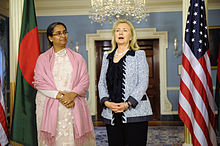
Bangladesh pursues a moderate foreign policy that places heavy reliance on multinational diplomacy, especially at the United Nations. In 1974, Bangladesh joined both the Commonwealth of Nations and the United Nations, and has since been elected to serve two terms on the Security Council – in 1978–1979 and 2000–2001. In the 1980s, Bangladesh played a lead role in founding the South Asian Association for Regional Cooperation (SAARC) in order to expand relations with other South Asian states. In more recent years, Bangladeshi foreign policy has focused on promoting regional economic integration in South Asia, as well as the wider neighbourhood.
Bangladesh's most important and complex foreign relationship is with India. This relationship is formed by historical and cultural ties and is strengthened because of India's involvement in liberating the people of Bangladesh from Pakistan. This forms an important part of the domestic political discourse. Bangladesh's relationship with India began on a positive note because of India's assistance in the independence war and subsequent reconstruction. Throughout the years, the relationship between the two countries has fluctuated for a number of reasons. A major source of tension between Bangladesh and India is the Farakka Dam. In 1975, India constructed a dam on the Ganges River 10.3 mi (16.6 km) from the Bangladeshi border. Bangladesh alleges that the dam diverts much needed water from Bangladesh and adds a man-made disaster to a country already plagued by natural disasters. However, both countries recognize the importance of good relations, regional security and South Asian economic integration. In 2009, Bangladeshi security forces launched a crackdown on Indian insurgents hiding in the country's border regions, captured and deported the leaders of several insurgent groups. Bangladesh and India have also agreed to develop regional connectivity and economic integration, along with Nepal and Bhutan. India's eastern states, as well as Nepal and Bhutan, are keen to gain access to Bangladesh's Chittagong and Mongla ports.
Bangladesh enjoys very warm ties with the People's Republic of China, and particularly in the past decade, there has been increased economic cooperation between them. Between 2006 and 2007, trade between the two nations rose by 28.5% and there have been agreements to grant various Bangladeshi commodities tariff-free access to the Chinese market. Cooperation between the Military of Bangladesh and the People's Liberation Army is also increasing, with joint military agreements signed and Bangladesh purchasing Chinese arms which range from small arms to large naval surface combat ships such as the Chinese Type 053H1 Missile Frigate.
The United States is a major development partner of Bangladesh, giving over six billion dollars in aid since 1972. American companies are the largest foreign investors in the country, and the US is also the largest market for Bangladeshi exports. Bangladesh participated in the US-led coalition during the 1991 Gulf War to liberate Kuwait, and supports the US-led reconstruction of Afghanistan. The US Military has taken part in several disaster management and relief operations in aftermath of devastating floods and cyclones to have hit Bangladesh, including Cyclone O2B and Cyclone Sidr.
As of 2012, the current strength of the army is around 300,000 including reservists, the air force 22,000, and navy 19,000. In addition to traditional defence roles, the military has been called on to provide support to civil authorities for disaster relief and internal security during periods of political unrest. Bangladesh is not currently active in any ongoing war, but it contributed 2,300 troops during Operation Desert Storm in 1991, and is the world's largest contributor (10,736) to UN peacekeeping forces. In May 2007, Bangladesh had major deployments in Democratic Republic of Congo, Liberia, Sudan, Timor-Leste and Côte d'Ivoire.
Economy
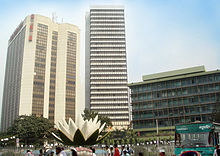
Bangladesh is a developing nation. Goldman Sachs named it one of the " Next Eleven". Bangladesh gradually decreased its dependency on foreign grant and loan from 85% (In 1988) to 2% (In 2010) for its annual development budget. Its per capita income in 2010 was US$641 compared to the world average of $8,985. In December 2005, the Central Bank of Bangladesh projected GDP growth around 6.5%.
Bangladesh has seen a dramatic increase in foreign direct investment. In order to enhance economic growth, the government set up several export processing zones to attract foreign investment. These are managed by the Bangladesh Export Processing Zone Authority.
The insufficient power supply constitutes an obstacle to growth. According to the World Bank, "among Bangladesh’s most significant obstacles to growth are poor governance and weak public institutions." In April 2010, Standard & Poor's awarded Bangladesh a BB- for a long term in credit rating which is below India and well over Pakistan and Sri Lanka in South Asia.
One significant contributor to the development of the economy has been the widespread propagation of microcredit by Muhammad Yunus (awarded the Nobel Peace Prize in 2006) through the Grameen Bank. By the late 1990s, Grameen Bank had 2.3 million members, along with 2.5 million members of other similar organisations.
Bangladesh government is planning for construction of the largest deep sea port in South Asia at Sonadia Island. The 500 billion taka project will be completed in multiple phases and enable Bangladesh to service the whole region as a maritime transport and logistics hub. India, China, Bhutan, Nepal and other neighbouring countries will be able to take full advantage of the strategic location and Bangladesh’s LDC status for exporting their goods, which are manufactured in Bangladesh.
Furthermore, with $7.5 billion a new international airport will be constructed. The airport is being modelled on Thailand’s Suvarnabhumi Airport in size and capacity.
To ease the chaotic traffic congestion in the capital Dhaka the government plans to construct more expressways, freeways, and flyovers. There is a plan to build an overhead Rapid transit called Dhaka Metro, but the progress is slow and controversial because of contracts and agreements.
Recently the government of Bangladesh signed a deal with a Chinese company to provide high-speed modern DEMU trains and is also going to construct metro rail system and high-speed electric powered inter city rail network. More airports, bridge (such as the multi-billion Padma Bridge project) national highways are also being constructed to facilitate trade and regional development.
Agriculture
According to FAOSTAT, Bangladesh is one of world's largest producers of: rice (4th), potato (11th), mango (9th), pineapple (16th), tropical Fruit (5th), onion (16th), banana (17th), jute (2nd), tea (11th).
Jute was once the economic engine of the country. Its share of the world export market peaked in the Second World War and the late 1940s at 80% and even in the early 1970s accounted for 70% of its export earnings. However, polypropylene products began to substitute for jute products worldwide and the jute industry started to decline. Bangladesh grows very significant quantities of rice, tea, potato, mango, onion and mustard.
Manufacturing
More than three-quarters of Bangladesh’s export earnings come from the garment industry in 2005. The industry began attracting foreign investors in the 1980s due to cheap labour and low conversion cost. In 2011–12 fiscal year the industry exported US$ 18 billion worth of products where in 2002 the exported amount was US$ 5 billion. Bangladesh has been ranked as the 4th largest clothing exporter by the WTO (The World Trade Organization) . whereas, according to The Economist Bangladesh is the world’s third-largest clothes-export industry. The industry now employs more than 3 million workers, 90% of whom are women.
There has also been a significant growth to Bangladesh's ship building industry in the last few years. The required ships and vessels in the country are being produced by the local shipbuilders. Furthermore, they have already started taking orders and executing them perfectly for foreign companies from Germany, Denmark and other European countries who prefer the cheap market of Bangladesh over their local market. The Khulna Shipyard have successfully completed building a Khulna Class LPC(Large Patrol Craft) and a LCVP(Landing Craft, Vehicle, Personnel) for the Bangladesh Navy and Bangladesh Army respectively, the cost being almost half of their import price. They are to build 5 more LPCs of the same class in the coming year.
Services
The tourism sector in Bangladesh has experienced massive growth in recent years. The majority of growth is contributed by local tourists. It is believed to be a major tourist destination if properly advertised. Nonetheless, few government and private initiatives have been taken to attract foreign tourists.
Though small in area, Bangladesh is quite rich in heritage with numerous historical and archeological sites. It has the longest natural unbroken sea beach and five World Heritage Sites. Among those are famous eighty one domed Shat Gombuj Mosque in Bagerhat, made by great Muslim saint Khan Jahan Ali in the 15th century; world's largest Mangrove forest Sundarbans which is also renowned for its world famous Royal Bengal Tiger.
There are several exotic archaeological sites in the northern parts of Bangladesh, including the temple city Puthia in Rajshahi; the largest and most ancient archaeological site, Mahasthangarh in Bogra; Among the best known Buddhist viharas in the Indian Subcontinent and one of the most important archaeological sites in the country, Paharpur in Naogaon, declared as a UNESCO World Heritage Site in 1985; Kantaji Temple, the most ornamental terracota Hindu temple in Bangladesh and many rajbaris or palaces of old zamindars. There are historic mosques too with vast architectural beauty like Shona Mosque built in 1493, Bagha Mosque, in 1523, Sixty Dome Mosque in 1459, etc.
Bangladesh has the largest shopping mall in South Asia, which is 13th largest in the world. It is Bashundhara City Shopping Mall which is situated at Karwan Bazar in Dhaka.
Demographics

| Historical populations in millions | ||
|---|---|---|
| Year | Pop. | ±% p.a. |
| 1971 | 67.8 | — |
| 1980 | 80.6 | 1.92% |
| 1990 | 105.3 | 2.67% |
| 2000 | 129.6 | 2.08% |
| 2010 | 148.7 | 1.37% |
| Source: OECD/World Bank | ||
The population of Bangladesh as of 15 March 2011 is 142.3 million (census 2011 results; this is a preliminary figure which has been disputed by the UN and now by Bangladeshis themselves), much less than recent (2007–2010) estimates of Bangladesh's population ranging from 150 to 170 million and it is the 8th most populous nation in the world. In 1951, the population was 44 million. It is also the most densely populated large country in the world, and it ranks 11th in population density, when very small countries and city-states are included.
Bangladesh's population growth rate was among the highest in the world in the 1960s and 1970s, when the country swelled from 65 to 110 million. With the promotion of birth control in the 1980s, the growth rate began to slow.The fertility rate now stands at 2.55, lower than India (2.58) and Pakistan (3.07) The population is relatively young, with 34% aged 15 or younger and 5% 65 or older. Life expectancy at birth is estimated to be 70 years for both males and females in 2012.
The overwhelming majority of Bangladeshis are ethnic Bengali, constituting 98% of the population. The remainder are mostly Biharis and indigenous tribal groups. There is also a small but growing population of Rohingya refugees from Burma around Cox's Bazaar, which Bangladesh seeks to repatriate to Burma. The tribal peoples are concentrated in the Chittagong Hill Tracts in the southeast. There are 45 tribal groups located in this region, the largest being the Chakma. The Hill Tracts region has been a source of unrest and separatism since and before the inception of Bangladesh. Outside the Hill Tracts, the largest tribal groups are the Santhals and Garos (Achiks), while smaller groups include the Kaibarta, Meitei, Mundas, Oraons, and Zomi.
Languages
More than 98% of Bangladeshis speak Bengali as their mother tongue as it is the official language. It is an Indo-Aryan language of Sanskrit origin with its own script. English is used as a second language among the middle and upper classes. English is also widely used in higher education and the legal system. Historically, laws were written in English and were not translated into Bengali until 1987 when the procedure was reversed. Some Dhakaiyas (Locales of Dhaka) & the Bihari population speaks Urdu, which was also the language associated with the government prior to separation from Pakistan.
Religion
After Bangladesh gained independence, Secularism was included in the original Constitution of Bangladesh in 1972 as one of the Four State Principles, the others being Democracy, Nationalism and Socialism. In 2010, the High Court upheld the secular principles of the 1972 constitution. The government of Bangladesh again made Islam the state religion in 2011. However, Bangladesh follows combined system of state laws and individual religious laws applicable to people of respective religious group. The main religion in Bangladesh is Islam (89.4% in 2010), but a significant percentage of the population adheres to Hinduism (9.6%). The majority of Muslims are Sunni, although a small number are Twelver Shias or Shias. Bangladesh is the fourth largest Muslim populated state after Indonesia, Pakistan and India.
Many people in Bangladesh practice Sufism, as historically Islam was brought to the region by Sufi saints. Sufi influences in the region go back many centuries. The largest gathering of Muslims in the country is the Bishwa Ijtema, held annually by the Tablighi Jamaat. The Ijtema is the second largest Muslim congregation in the world after the Hajj. Other religious groups include Buddhists (0.7%, mostly Theravada), Christians (0.2%, mostly of the Roman Catholic denomination), and Animists (0.1%).
Education
Bangladesh has a low literacy rate, estimated at 61.3% for males and 52.2% for females in 2010. The educational system in Bangladesh is three-tiered and highly subsidized. The government of Bangladesh operates many schools in the primary, secondary, and higher secondary levels. It also subsidises parts of the funding for many private schools. In the tertiary education sector, the government also funds more than 15 state universities through the University Grants Commission.
The education system is divided into 5 levels: Primary (from grades 1 to 5), Junior Secondary (from grades 6 to 8), Secondary (from grades 9 to 10), Higher Secondary (from grades 11 to 12) and tertiary. The five years of lower secondary education concludes with a Secondary School Certificate (SSC) Examination but since 2009 it concludes with a Primary Education Closing (PEC) Examination. Also earlier Students who pass this examination proceed to four years Secondary or matriculation training, which culminate in a Secondary School Certificate (SSC) Examination but since 2010 the Primary Education Closing (PEC) passed examinees proceed to three years Junior Secondary, which culminate in a Junior School Certificate (JSC) Examination. Then students who pass this examination proceed to two years Secondary or matriculation training, which culminate in a Secondary School Certificate (SSC) Examination. Students who pass this examination proceed to two years of Higher Secondary or intermediate training, which culminate in a Higher Secondary School Certificate (HSC) Examination. Education is mainly offered in Bengali, but English is also commonly taught and used. A large number of Muslim families send their children to attend part-time courses or even to pursue full-time religious education, which is imparted in Bengali and Arabic in madrasahs.
Bangladesh conforms fully to the Education For All (EFA) objectives, the Millennium Development Goals (MDG) and international declarations. Article 17 of the Bangladesh Constitution provides that all children between the ages of six and ten years receive a basic education free of charge.
Universities in Bangladesh are mainly categorised into three different types: public university (government owned and subsidized), private university (private sector owned universities) and international university (operated and funded by international organizations). Bangladesh has some thirty-four public, sixty-four private and two international universities. National University has the largest enrolment amongst them and University of Dhaka (established 1921) is the oldest university of the country. Bangladesh University of Engineering and Technology (BUET) is the oldest and prominent engineering university in Bangladesh. Shahjalal University of Science and Technology is the first specialized science and technology university of the country. Now Bangladesh has eight science and technology universities. Islamic University of Technology (IUT) is the only international university in engineering fields powered by OIC. Some other Universities are also well known such as Rajshahi University, Chittagong University, Jahangirnagar University, Khulna University, Bangabandhu Sheikh Mujib Medical University, Hajee Mohammad Danesh Science & Technology University, North South University, BRAC University, Ahsanullah University of Science and Technology, American International University-Bangladesh, Begum Gulchemonara Trust University, Bangladesh Agricultural University etc. Bangladeshi universities are accredited by and affiliated with the University Grants Commission (UGC), a commission created according to the Presidential Order (P.O. No 10 of 1973) of the Government of the People's Republic of Bangladesh.
Health
Health and education levels remain relatively low, although they have improved recently as poverty (31% at 2010) levels have decreased. Most Bangladeshis continue to live on subsistence farming in rural villages. For those in rural areas, village doctors with little or no formal training constitute 62% of the healthcare providers practising modern medicine and the formally trained providers are occupying a mere 4% of the total health workforce. A survey conducted by Future Health Systems revealed significant deficiencies in treatment practices of village doctors, with a wide prevalence of harmful and inappropriate drug prescriptions. There are market incentives for accessing health care through informal providers and it is important to understand these markets in order to facilitate collaboration across actors and institutions in order to provide incentives for better performance.
A 2007 study of 1000 households in rural Bangladesh found that direct costs (payment to formal and informal health care providers) and indirect costs (loss of earnings associated with workdays lost due to illness) associated with illness were important deterrents to accessing health care from qualified healthcare providers. A community survey with 6183 individuals in rural Bangladesh found a clear gender difference in treatment-seeking behaviour, with women less likely to seek treatment compared to men. The use of skilled birth attendants, however, has risen between 2005 and 2007 by women in all wealth quintiles except the highest quintile. A pilot community empowerment tool, called a health watch, was successfully developed and implemented in south-eastern Bangladesh in order to improve uptake and monitoring of public health services.
The poor health conditions in Bangladesh is attributed by the lack of healthcare and services provision by the government. The total expenditure on healthcare as a percentage of their GDP was only 3.35% in 2009, according to a World Bank report published in 2010. The number of hospital beds per 10 000 population is 4. The General government expenditure on healthcare as a percentage of total government expenditure was only 7.9% as of 2009 and the citizens pay most of their health care bills as the out-of-pocket expenditure as a percentage of private expenditure on health is 96.5%.
Malnutrition has been a persistent problem for the poverty-stricken country. The World Bank estimates that Bangladesh is ranked 1st in the world of the number of children suffering from malnutrition In Bangladesh, 26% of the population are undernourished and 46% of the children suffers from moderate to severe underweight problem. 43% of children under 5 years old are stunted. One in five preschool age children are vitamin A deficient and one in two are anaemia. Child malnutrition in Bangladesh is amongst the highest in the world. Two-thirds of the children, under the age of five, are under-nourished and about 60% of them, who are under six, are stunted. More than 45 percent of rural families and 76 percent of urban families were below the acceptable caloric intake level.
Culture
Reflecting the long history of the region, Bangladesh has a culture that encompasses elements both old and new.
Literature
The Bengali language boasts a rich literary heritage, which Bangladesh shares with the Indian state of West Bengal. The earliest literary text in Bengali is the 8th century Charyapada. Medieval Bengali literature was often either religious (for example, Chandidas), or adapted from other languages (for example, Alaol). Bengali literature reached its full expression in the 19th century, with its greatest icons being poets, the national poet Kazi Nazrul Islam, Rabindranath Tagore, Sarat Chandra, Jasim Uddin, Jibanananda Das, Shamsur Rahman, Al Mahmud, Sukanta Bhattacharya, Ishwar Chandra Vidyasagar, Michael Madhusudan Dutt and present day Humayun Ahmed, Muhammed Zafar Iqbal. Bangladesh also has a long tradition in folk literature, for example Maimansingha Gitika, Thakurmar Jhuli and stories related to Gopal Bhar, Birbal and Molla Nasiruddin.
Music and Arts
The musical tradition of Bangladesh is lyrics-based (Baniprodhan), with minimal instrumental accompaniment. Numerous musical traditions exist including Gombhira, Bhatiali and Bhawaiya, varying from one region to the next. Folk music is accompanied by the ektara, an instrument with only one string. Other instruments include the dotara, dhol, flute and tabla. Bangladesh also has an active heritage in North Indian classical music. Similarly, Bangladeshi dance forms draw from folk traditions, especially those of the tribal groups, as well as the broader Indian dance tradition. Bangladesh produces about 80 films a year. Mainstream Hindi films are also quite popular.
Cuisine
The culinary tradition of Bangladesh has close relations to surrounding Bengali and North-East Indian cuisine as well as having its own unique traits. Rice and fish are traditional favourites. Biryani is a favourite dish of Bangladesh and this includes egg biryani, mutton biryani and beef biryani. Bangladeshis make distinctive sweetmeats from milk products, some common ones being Rôshogolla, Rasmalai, Rôshomalai, chômchôm and kalojam.
Dress
The shari (shaŗi) is by far the most widely worn dress by Bangladeshi women. A guild of weavers in Dhaka is renowned for producing saris from exquisite Jamdani muslin. The salwar kameez (shaloar kamiz) is also quite popular, especially among the younger females, and in urban areas some women wear western attire. Among men, western attire is more widely adopted. Men also wear the kurta-paejama combination, often on special occasions, and the lungi, a kind of long skirt for men.
Festivals
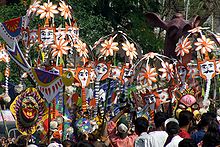
The Muslim holidays of Eid ul-Fitr and Eid ul-Adha, the Bengali New Year, Independence Day, and Durga Puja by the significant Hindu community of Bangladesh, see the most widespread celebrations in the country. Other major Hindu festivals are Kali Puja, Saraswati Puja, and Krishna Janmashtami; alongside the Buddhist festival of Buddha Purnima, which marks the birth of Gautama Buddha, and Christmas, called Borodin ("Great day"), are all (except Saraswati and Kali Puja) national holidays.
Pohela Boishakh, the Bengali new year, is the major festival of Bengali culture and sees widespread festivities. Of the major holidays celebrated in Bangladesh, only Pohela Boishakh comes without any preexisting expectations (specific religious identity, culture of gift-giving, etc.). Unlike holidays like Eid ul-Fitr, where dressing up in lavish clothes has become a norm, or Christmas where exchanging gifts has become an integral part of the holiday, Pohela Boishakh is really about celebrating the simpler, rural roots of the Bengal. As a result, more people can participate in the festivities together without the burden of having to reveal one's class, religion, or financial capacity. Other cultural festivals include Nabonno, and Poush porbon (festival of Poush), both Bengali harvest festivals.
Alongside these are national days like the remembrance of 21 February 1952 Language Movement Day ( International Mother Language Day), Independence Day and Victory Day. On Language Movement Day, people congregate at the Shaheed Minar in Dhaka to remember the national heroes of the Bengali Language Movement, and at the Jatiyo Smriti Soudho on Independence Day and Victory Day to remember the national heroes of the Bangladesh Liberation War. These occasions are observed with public ceremonies, parades, rallies by citizens, political speeches, fairs, concerts, and various other public and private events celebrating the history and traditions of Bangladesh. TV and radio stations broadcast special programs and patriotic songs. And many schools and colleges organise fairs, festivals, and concerts in which citizens from all levels of society can participate.
Architecture
Bangladesh has appealing architecture from historic treasures to contemporary landmarks.The architecture of Bangladesh has a long history and is rooted in Bangladesh's culture, religion and history. It has evolved over centuries and assimilated influences from social, religious and exotic communities. The architecture of Bangladesh bears a remarkable impact on the lifestyle, tradition and cultural life of Bangladeshi people. Bangladesh has many architectural relics and monuments dating back thousands of years.
Sports
Cricket is one of the most popular sports in Bangladesh, followed by football (soccer). The national cricket team participated in their first Cricket World Cup in 1999, and the following year was granted elite Test cricket status. But they have struggled to date, recording only three Test match victories, one against Zimbabwe in 2005 and the other two in a series win of 2–0 against the West Indies in 2009. The team has been more successful in One Day International cricket. In July 2010, they celebrated their first ever win over England in any form of match. Later in 2010, they managed to whitewash New Zealand for the first time in history. In late 2012, they have won a 5-match home ODI series 3-2 against a full-strength West Indies National team. In 2011, Bangladesh successfully co-hosted the ICC Cricket World Cup 2011 with India and Sri Lanka. In 2012, the country hosted the Micromax Asia Cup. The team beat India and Sri Lanka but failed to keep the reputation in the final game against Pakistan. However, it was the first time Bangladesh had advanced to the final of any major cricket tournament.
They participated at the 2010 Asian Games in Guangzhou, defeating Afghanistan to claim their Gold Medal in the first ever cricket tournament held in the Asian Games. Kabaddi is a very popular game in Bangladesh, especially in the villages. Often called the 'game of rural Bengal', it is now the National Game of Bangladesh. In some areas Kabaddi is still known as [Ha-Du-Du], but Ha-Du-Du had no definite rules and was played with different rules in different areas. [Ha-Du-Du] was renamed Kabaddi and given the status of the National Game in 1972. Other popular sports include field hockey, tennis, badminton, handball, basketball, volleyball, chess, shooting, angling. The Bangladesh Sports Control Board regulates 29 different sporting federations.


